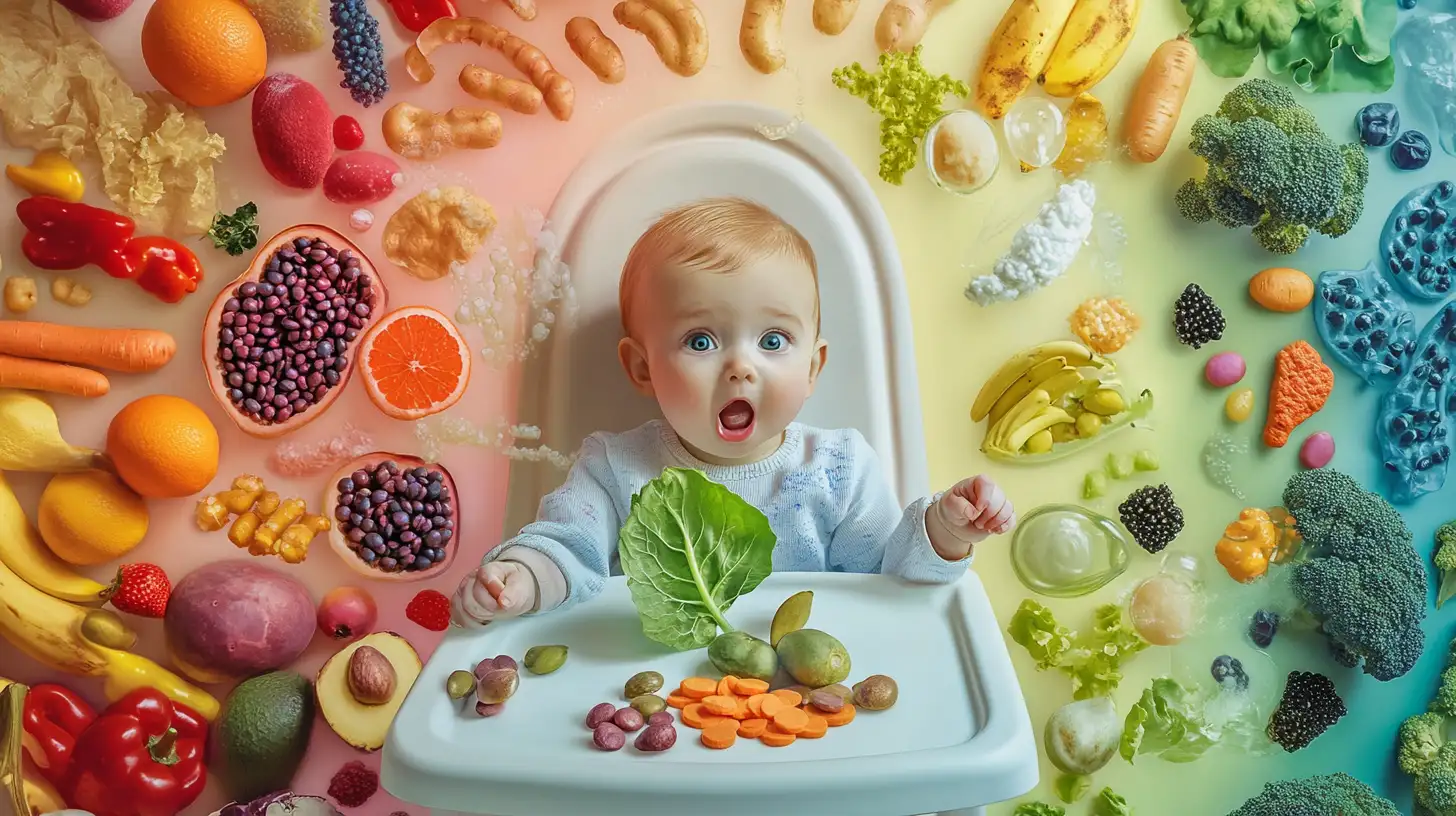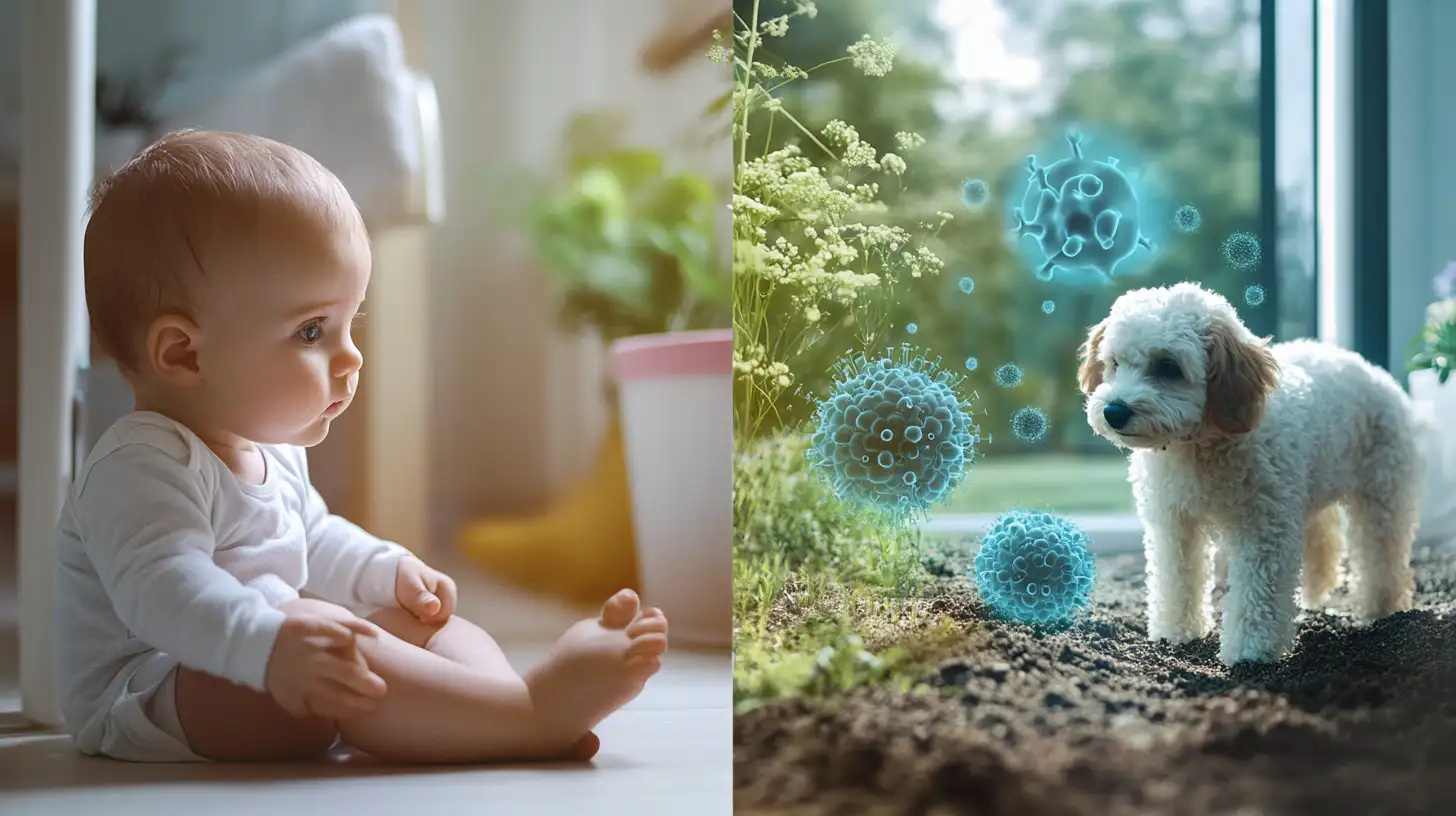Table of Contents
ToggleYour Baby’s Invisible Universe: How the First 1000 Days Shape Their Lifelong Health
Have you ever looked at your baby sleeping peacefully and wondered what magical processes are happening inside their tiny body? I’m not talking about their adorable little dreams or their growing bones. I’m talking about something far more powerful yet completely invisible to the naked eye – their microbiome.
This may sound crazy, but the way to raise a healthy child isn’t what you think. The tiniest organisms living inside your baby’s body might be more important than all those expensive gadgets and toys we’re convinced our children need. And I wish someone had told me this sooner.
I remember sitting with my sister-in-law at our family dinner in Trinidad last month. She just had her first baby and was overwhelmed with advice from everyone. Use this special soap, Don’t let anyone kiss the baby, Sanitize everything twice. She looked at me with tired eyes and asked, What’s actually important? What should I really be focusing on?
What I shared with her that evening changed her entire approach to parenting. Because here’s the truth – we’ve been overthinking it. We’ve been so focused on keeping babies clean that we’ve missed something fundamental about how their bodies develop strength from the very beginning.
In this article, I’m going to share with you the revolutionary science of your baby’s microbiome – that collection of trillions of bacteria, fungi, and other microorganisms that live in and on your child – and how the decisions you make in the first 1000 days can set the foundation for their lifelong health.

The Invisible Universe Inside Your Baby
Let me explain something fascinating. Your baby wasn’t born sterile. That’s right – despite what we believed for decades, your baby’s microbiome begins forming before birth. Recent research shows that bacteria exist in the placenta, amniotic fluid, and even the umbilical cord.
But it’s the moment of birth that provides the first massive microbial inheritance. During vaginal delivery, your baby gets coated with billions of beneficial bacteria from your birth canal and intestinal tract. This is literally their first inheritance – not money or property, but microscopic organisms that will help protect them for life.
I used to think being ultra-clean was the goal of good parenting. I sanitized everything my firstborn touched. Every bottle, every toy, every surface. I was exhausted trying to create this perfect, germ-free environment. And you know what? Science now shows I was working against my baby’s development, not for it.
Because here’s what researchers have discovered: babies delivered by C-section miss this initial microbial coating and instead get colonized primarily by skin bacteria and hospital environmental microbes. This difference can still be detected in children’s microbiomes years later and has been associated with higher rates of asthma, allergies, and even obesity.
Now, if you had a C-section, please don’t worry. I’m not sharing this to cause anxiety but to explain why practices like skin-to-skin contact immediately after birth and breastfeeding become even more important – they help provide some of those beneficial microbes your baby needs.
The point is that this invisible universe inside your baby isn’t something to fear or constantly sanitize away. It’s something to nurture, because when you care for their microbiome, you’re caring for their future health in ways we’re only beginning to understand.

Breastfeeding: More Than Just Nutrition
Have you ever heard of HMOs? No, not the health insurance! I’m talking about Human Milk Oligosaccharides – complex sugars found abundantly in breast milk that have absolutely revolutionized our understanding of infant feeding.
Here’s something that blew my mind: your baby can’t digest these sugars. That’s right – up to 15% of breast milk consists of these complex carbohydrates that your baby’s body doesn’t directly use. So why are they there?
Because they’re not food for your baby – they’re food for your baby’s gut bacteria! These HMOs specifically nourish beneficial bacteria like Bifidobacterium infantis, which then produce short-chain fatty acids that reduce inflammation and help develop your baby’s immune system.
My grandmother in Jamaica used to say, Good food makes good people. She wasn’t a scientist, but she understood something fundamental that science is now confirming – what we feed ourselves and our children shapes who we become on a cellular level.
I remember the struggle of my breastfeeding journey – the cracked nipples, the sleepless nights, the constant worry about supply. There were moments I wanted to give up. But understanding that breast milk isn’t just food – it’s medicine, it’s immune protection, it’s microbial cultivation – gave me the strength to continue.
And if breastfeeding isn’t possible for you? That’s okay too. The newest generation of infant formulas are beginning to incorporate HMO equivalents and probiotics. And there are many other ways to support your baby’s microbiome development that I’ll share as we continue.
Because what matters isn’t perfection. What matters is doing your best with the information you have. And now that you understand breast milk’s role in developing your baby’s microbiome, you can make decisions that align with this knowledge, whether that means extended breastfeeding, donor milk, or specialized formula.

Antibiotics, C-Sections, and Recovery Strategies
Let me be clear about something important: medical interventions like antibiotics and C-sections save lives. Full stop. Sometimes they are absolutely necessary, and we should be grateful they exist.
But here’s what the latest research is showing us: these interventions come with microbial consequences. Each course of antibiotics your baby receives wipes out not just the harmful bacteria causing infection, but also many beneficial bacteria they need for proper development.
I saw this firsthand when my son developed an ear infection at six months. The antibiotics cleared the infection quickly, but afterwards he developed eczema patches that he’d never had before. The research now suggests this wasn’t coincidental – the disruption to his microbiome likely contributed to this new immune response.
So what do you do when these interventions are necessary? You develop a recovery strategy. Think of it like replanting a garden after a storm has damaged it.
For babies born via C-section, practices like vaginal seeding (where gauze is placed in the mother’s vagina before surgery and then wiped on the baby’s face after birth) are being studied, though you should only do this under medical supervision.
For babies who need antibiotics, probiotic supplements specifically designed for infants can help repopulate their gut with beneficial bacteria. Foods rich in prebiotics (the food for good bacteria) become especially important once solid foods begin.
My great-aunt from Barbados taught me something valuable. When someone in the family took antibiotics, she would prepare a special fermented drink afterwards made with local fruits. Science now confirms what traditional wisdom knew – fermented foods help restore microbial balance.
The key is not to avoid necessary medical interventions, but to be proactive about supporting your baby’s microbiome recovery afterwards. Because with the right strategies, their invisible universe can bounce back stronger than before.

Introducing Solids: Feeding Their Microbes
Think about this for a moment – when you introduce solid foods to your baby, you’re not just feeding your child. You’re feeding trillions of microbes that live inside them. And those microbes, in turn, help determine how your child’s body processes those foods.
This realization completely changed how I approached my baby’s first foods. Because it’s not just about the nutrients your baby needs today – it’s about cultivating the right microbial garden that will protect them for decades to come.
Recent research has shown that a diverse diet leads to a diverse microbiome. And diversity is the key to resilience and health. Each different plant food introduces different fibers and polyphenols that feed different beneficial bacteria.
I remember the day I offered my daughter her first taste of callaloo, a nutrient-rich leafy green popular in Caribbean cooking. Her face scrunched up at the unfamiliar flavor, and she wasn’t sure about it at first. But I persisted (gently), offering it prepared different ways over the following weeks. Today, it’s one of her favorite foods.
What the science tells us is that those initial reactions to bitter or sour flavors don’t mean your baby doesn’t like the food. Their taste preferences are still developing, and it can take 10-15 exposures to a new food before acceptance. Each exposure is training not just their palate but their microbiome as well.
Here’s what worked for our family: introducing one new food every 2-3 days, particularly focusing on:
- Colorful fruits and vegetables (different colors mean different polyphenols)
- Fermented foods like yogurt (which contain live beneficial bacteria)
- Foods rich in resistant starch like slightly green bananas and cooled sweet potatoes (excellent microbiome fuel)
- Diverse protein sources including plant proteins like beans and lentils
- Healthy fats that support microbiome function, like avocado and olive oil
And what about food allergies? The science has completely reversed on this too. We now know that early introduction of potential allergens (like peanuts, eggs, and seafood) – between 4-11 months while still breastfeeding – actually reduces the risk of developing allergies, likely through microbiome-mediated immune training.
The beauty of feeding for microbiome health is that it aligns perfectly with overall nutritional goals – whole foods, diverse plants, limited processed foods and sugar. When you nourish their microbes, you nourish your child in the most fundamental way possible.

The Dirt on Cleanliness: Finding Balance
This may be the most controversial thing I’ll say in this entire article, but here goes: we need to let our babies get dirty. Not neglectfully dirty, but intentionally, beneficially dirty.
I used to be that parent following my crawling baby around with sanitizing wipes. Every dropped toy got a thorough cleaning. Every surface was disinfected daily. I thought I was protecting him. But science now suggests I might have been doing exactly the opposite.
The hygiene hypothesis has evolved into what scientists now call the old friends theory – the idea that our immune systems evolved alongside certain microbes, and exposure to these microbes during early development is necessary for proper immune regulation.
What does this mean practically? It means rethinking our relationship with cleanliness.
I remember visiting my cousin’s home in rural Trinidad. Her children played barefoot in the garden, dug in the soil with their hands, and had daily contact with their pet dog. At first, my urban parenting instincts were horrified. But those children had almost no allergies or asthma, despite strong family history of both.
Recent research has confirmed what my observations suggested: children who grow up on farms, with pets, or with regular exposure to natural environments have significantly lower rates of allergic and autoimmune conditions. The microbes they encounter train their immune systems not to overreact to harmless substances.
So what’s the balanced approach? Here’s what research suggests:
- Regular time outdoors in natural settings, allowing touch and exploration
- Pets can be beneficial microbial exposures (studies show children with dogs have more diverse microbiomes)
- Save antibacterial products for high-risk situations (raw meat preparation, illness in the home)
- Use plain soap and water for routine cleaning and hand washing
- Allow safe exploration of diverse environments rather than restricting babies to sanitized spaces
This doesn’t mean we abandon hygiene – proper handwashing, safe food handling, and appropriate cleaning still matter. But we can be more strategic, focusing our sterilization efforts where they matter most and allowing beneficial microbial exposures elsewhere.
The invisible universe within your baby gets stronger through appropriate challenges, not through perfect protection. Finding that balance is the art of modern parenting, informed by ancient wisdom.
Your Family’s Microbial Legacy
Here’s a powerful thought that changed my perspective on parenting: the decisions you make today about your baby’s microbiome aren’t just affecting them now. They’re potentially shaping the health of your grandchildren and great-grandchildren too.
This isn’t mystical thinking – it’s emerging science. Researchers now understand that while our DNA remains relatively fixed, our epigenome (which controls which genes are expressed) is influenced by our microbiome. And these epigenetic patterns can be inherited.
I stopped seeing my daily parenting decisions as isolated choices and started seeing them as part of a legacy I’m creating. When I prepare fermented foods from recipes passed down through generations in my family, I’m not just preserving cultural traditions – I’m preserving microbial diversity that might benefit my children’s children.
The choices you make in these crucial first 1000 days of your baby’s life – from birth to age three – create patterns that can last a lifetime. The microbes that colonize them now will help determine how their immune system develops, how they process food, even how their brain functions.
But here’s the thing I want you to remember most from everything I’ve shared: while this information is powerful, it doesn’t need to be overwhelming. You don’t need to get everything perfect.
Because microbiomes are resilient. They can recover. They can adapt. Just like our children.
The goal isn’t microbial perfection – it’s microbial resilience. Creating an internal ecosystem that’s diverse enough, strong enough, and balanced enough to weather life’s inevitable challenges.
So if you’ve had the C-section you didn’t plan for, if breastfeeding didn’t work out, if antibiotics were necessary – release the guilt and focus on the many opportunities ahead to support your baby’s developing microbiome.
Because when you embrace your progress as a parent versus trying to achieve some perfect result, you will achieve more than you ever thought possible. Knowing that what you have to offer – your love, your attention to these details that matter, your willingness to learn and adapt – is enough. You are enough for this child.
By taking each next step forward without knowing exactly how it will end, but trusting in this process that nature has perfected over millennia, you’re giving your child the best possible start.
And if you’ve given your best with the knowledge you have at each step of the way, then you have already won. Your baby has already won. And the invisible universe inside them will continue to flourish, creating the foundation for their lifelong health.
Remember – you become powerful when you focus on the right things. And in these early years, nurturing your baby’s microbiome might just be one of the most important things you can do.
Step into Sue Brown's World of Baby Care, where you'll find a treasure trove of knowledge and wisdom waiting to be explored. Sue's dedication to providing accurate and up-to-date information on baby care shines through in every article, blog post, and resource she shares. From newborn essentials to sleep training tips, breastfeeding advice to nurturing your baby's development, Sue covers a wide range of topics that are essential for every parent to know. Her warm and compassionate approach creates a sense of community and reassurance, making her website a safe haven for parents seeking guidance and support. Let Sue Brown be your partner in this beautiful journey of parenthood, as she empowers you to create a loving, nurturing, and thriving environment for your little one.
- Indoor Air Quality for Infant Respiratory Health - October 20, 2025
- Positive Discipline Foundations: Setting the Stage From Infancy - October 18, 2025
- 2025’s Most Innovative Baby Products Worth the Investment - October 16, 2025



